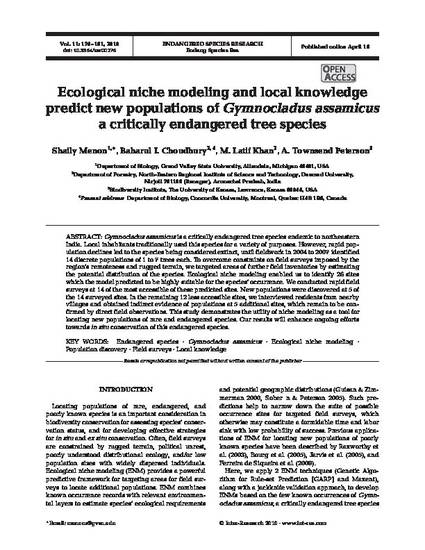
Article
Ecological Niche Modeling and Local Knowledge Predict New Populations of Gymnocladus assamicus a Critically Endangered Tree Species
Endangered Species Research
(2010)
Abstract
Gymnocladus assamicus is a critically endangered tree species endemic to northeastern India. Local inhabitants traditionally used this species for a variety of purposes. However, rapid population declines led to the species being considered extinct, until fieldwork in 2004 to 2007 identified 14 discrete populations of 1 to 7 trees each. To overcome constraints on field surveys imposed by the region’s remoteness and rugged terrain, we targeted areas of further field inventories by estimating the potential distribution of the species. Ecological niche modeling enabled us to identify 26 sites which the model predicted to be highly suitable for the species’ occurrence. We conducted rapid field surveys at 14 of the most accessible of these predicted sites. New populations were discovered at 5 of the 14 surveyed sites. In the remaining 12 less accessible sites, we interviewed residents from nearby villages and obtained indirect evidence of populations at 5 additional sites, which remain to be confirmed by direct field observations. This study demonstrates the utility of niche modeling as a tool for locating new populations of rare and endangered species. Our results will enhance ongoing efforts towards in situ conservation of this endangered species.
Keywords
- endangered species,
- <em>Gymnocladus assamicus</em>,
- ecological niche modeling,
- population discovery,
- field surveys,
- local knowledge
Disciplines
Publication Date
Spring April 16, 2010
Citation Information
Shaily Menon, Baharul I Choudhury, M. Latif Khan and A. Townsend Peterson. "Ecological Niche Modeling and Local Knowledge Predict New Populations of Gymnocladus assamicus a Critically Endangered Tree Species" Endangered Species Research Vol. 11 (2010) Available at: http://works.bepress.com/shaily_menon/11/
